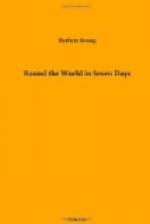His aim was to cross the Turkish provinces in Asia and strike the Persian Gulf, a slightly longer route than if he had gone through central Persia, but having the great advantage of affording a possible half-way house at Bagdad, Basra, or Bushire, in each of which towns he would almost certainly find Europeans. It had the further advantage that, when he had once sighted the Gulf, he would have no anxiety about the accuracy of his course, since by keeping generally to the coastline of Persia and Baluchistan he could not fail to arrive at Karachi. It was a great thing to be independent of nautical observations, for as he approached the shores of India it might be difficult to take his bearings by his instruments, this being the season of the monsoon.
When he left Constantinople his anemometer indicated a velocity of eighteen miles in the south-west wind, which, as he was steering south-east, was partly in his favour. One of the disabilities which he, in common with all airmen, suffered, was the impossibility of ascertaining the velocity of the wind when he was fairly afloat. He had to make allowance for it by sheer guesswork, unless he was prepared to slow down or even to alight. He had reckoned that, even with the slight assistance of the wind, he could hardly hope to reach the head of the Persian Gulf before six o’clock, which would be past nine by the sun; but he thought he might reasonably expect to reach the Euphrates before sunset; and since the map assured him that that river ran a fairly direct course to the Gulf, he might follow it without much difficulty if the night proved clear, and so assure himself that he was not going astray.
The country over which he was now flying was hilly, and he kept at a fairly high altitude. The map showed him that the great Taurus range lay between him and the eastern extremity of the Mediterranean. Within an hour and a half after leaving Constantinople he came in sight of its huge bleak masses stretching away to right and left, but still a hundred miles or more distant, although, on the right, spurs of the Cilician part of the range jutted out much nearer to him. On the right, too, he descried from his great height a broad and glittering expanse of water, which the map named Lake Beishehr. Making for the gap in the mountains near the Cilician coast he found himself passing over a comparatively low country, and soon afterwards descried the blue waters of the Mediterranean and the island of Cyprus rising out of it a hundred miles away.
Setting now a more easterly course, he passed over an ironbound coast, its perpendicular cliffs fringed with dwarf pines; and then over a large town which could be none other than Antioch. Half-an-hour more brought him within sight of another city, doubtless Aleppo. He still steered almost due east, though a point or two southward would be more direct, because he wished to avoid the Syrian desert; a breakdown in such a barren tract of country would mean a fatal delay. Soon afterwards he reached a broad full river, flowing rapidly between verdant banks.




